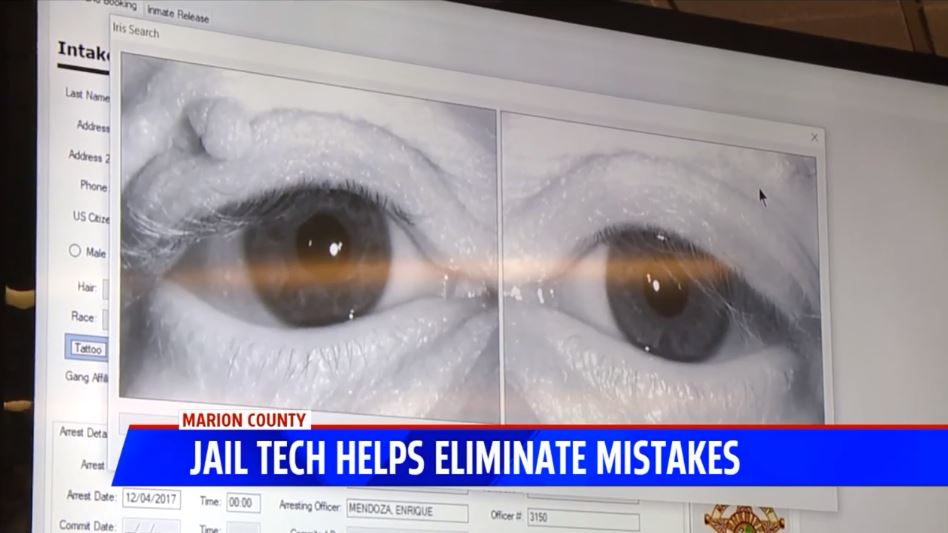
- Jun 7, 2018
- BI2 Technologies Team
- IRIS™
- 0 Comments
INDIANAPOLIS, Ind.– For years, the Marion County Jail was plagued by the inadvertent releases and misidentification of offenders, a byproduct of faulty sheriff’s software and training and the lies told by people under arrest.
With $15,000 transferred from the profits of the inmates’ commissary fund, Sheriff John Layton has invested in the Inmate Recognition Identification System known by its acronym IRIS.
The system literally looks into the eyes of the offender to produce a one-of-a-kind identification confirmation.
“An iris scan of the colored part of your eye is 12 times more accurate than fingerprints,” said Peter Flynn of BI2 Technologies.
“It’s not only gonna help us identify in a matter of seconds these criminals from other jurisdictions wherever they may be within our country, but because of that and so quickly that it will save lives,” said Layton.
The intent is to pin down an arrestee’s identification the day he or she walks into jail and the day they walk out and determine their criminal record and how dangerous they are.
Marion County will be the first jurisdiction in Indiana to join a network of more than 200 law enforcement agencies across the country.
Unfortunately, if an offender has lied about who they were in the past, the iris scan will refer to that alias, but at least jail commanders will be able to begin drilling down on an arrestee’s true identity.
Layton is also in the process of purchasing two full body scanners, similar to those utilized at Indianapolis International Airport, in an effort to combat the smuggling of drugs and other contraband into the jail.
Such a scanner came on-line this week at the Duvall Residential Work Release Center at 1810 Ludlow Avenue, where Community Corrections Executive Director Tyler Bouma expects the device will prohibit the types of drug overdose incidents that recently sent more than a dozen offenders to the hospital.
The sheriff has struggled with security at the main jail, which dates back to the mid-1960s.
After Layton threatened to end offender transportation services last summer, and closed the Arrestee Processing Center, Mayor Joe Hogsett called for a full financial and operational audit of the Marion County Sheriffs Office.
This week the Administration and Finance Committee of the City County Council authorized spending $220,000 to hire an outside auditing firm to exam the sheriff’s books and operations pending full council approval.
“We expect that the audit will show what we’ve contended for a long time, that we do need a real cost of what it takes to operate the sheriff’s office, but especially the jail and arrestee services,” said Col. Louis Dezelan. “This financial review by KPMG is gonna focus on arrestee services, the cost of medical services for arrestees, the cost of running the jail and our fleet.
Dezelan said the upcoming 2019 sheriff’s budget will include arrestee transportation, which Layton contends is not part of his constitutional responsibility.
“The inmate transportation will be part of the budget as long as the sheriff has that responsibility,” said Dezelan. “I think what he’s done is he wants to take a look at the result of the financial review before he moves ahead with continuing or not continuing offering the arrestee services.”
The financial audit will inform this summer’s talks over the sheriff’s budget while the operational examination will be ready for Layton’s successor on January 1.
Typically, the sheriff’s office has four jail wagons on the streets of Marion County every night, providing offender transportation for IMPD and several local police departments.
Staff shortages have resulted in as few as two wagons on patrol as drivers are pressed into jail duty, leaving offender pick-ups delayed or forcing police officers to drive their own prisoners to the basement of the City County Building for processing.
“It causes us to take a little more time to get an arrestee to the jail, but they still get them all picked up,” said Dezelan, who maintains the shortage of wagons is not an officer or public safety issue. “They don’t put more people in a wagon because there are fewer wagons. It might take a little longer for the deputy to pick somebody up.”
Layton is hopeful an audit will confirm his position that lower pay for deputies leads to excessive turnover and overtime spending and that the sheriff bears a disproportionate share of the costs when an inmate is hospitalized.
Dezelan said an upside to the funding crisis and closure of the Arrestee Processing Center and moving those operations to the CCB has been a more streamlined offender intake system.
“One of the effects is it helps to get people to court faster and the courts have done a great job to help us get people through the system,” Dezelan said.
Judges have also utilized relaxed bond rules and expanded community correction services to send more offenders home on pre-trial detention with GPS monitoring units as opposed to housing them in the near-capacity jail.
The IRIS system is expected to drastically reduce the time it takes deputies to book an arrestee into the jail.
Article was written by Russ McQuaid
